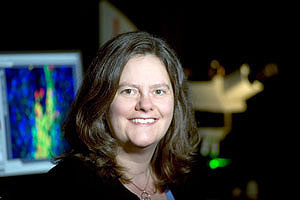May 19, 2009 - By Janelle Weaver

Neurologist Marion Buckwalter is intent on discovering how the brain repairs itself after stroke.
Eyes still dilated and blinded by the ambient light of her office, Marion Buckwalter had just raced over from her optometrist to meet with a student. Though she couldn't look through the microscope or read the latest neurology articles, she figured she could still talk with a student about her research project.
Buckwalter, MD, PhD, is not the kind of person who lets obstacles, let alone minor inconveniences, get in the way of her goals. The energetic assistant professor of neurology and neurological sciences is intent on discovering how the brain repairs itself after stroke - the leading cause of serious, long-term disability in the United States, according to the Centers for Disease Control and Prevention. She's hoping she'll succeed in developing a drug that improves recovery from the damage caused by stroke.
While most stroke medications help to prevent brain attacks, there is only one drug on the market to treat stroke: tissue plasminogen activator, or tPA, which breaks up clots that obstruct the flow of blood to the brain. Unfortunately, this drug is effective only within the first few hours after the stroke occurs.
'By the time patients come into the hospital, most of the cells have already died. There are no drugs to help these people recover. Discovering such a drug would really help a lot of people,' said Buckwalter.
Although stroke is the third-leading cause of death in the United States, approximately 82 percent of the 795,000 people who suffer a stroke each year survive, according to the American Heart Association. Many survivors are left with impaired memory, motor and language functions. Through long-term rehabilitation, patients must train spared portions of their brain to undertake new functions, but there is a huge range in their success, and many never fully recover.
Buckwalter didn't always know she would be investigating ways to improve stroke recovery. Having earned an MD and PhD in genetics from the University of Michigan in 1996, she initially performed gene-mapping studies and wanted to become a pediatric gene therapist. 'I liked pediatrics but was more fascinated by neurology,' she said. 'Neurology is a field where diagnosis takes place after thoughtful exams, not just lab tests. It's like puzzle solving: You get clues that you have to put together to learn what's going on.'
Once she saw firsthand the devastating effects of stroke during her residency at UCSF, her interests quickly shifted to figuring out how patients can recover from brain injuries. She noticed that younger people recover better from brain injury and stroke. 'There are mechanisms in the young brain that can compensate for or repair injury, but these mechanisms don't exist or don't work in adults,' she said.
The key factor controlling recovery may be tied to the body's natural defense mechanism, the immune system, said Buckwalter, who noticed that most of her time with critical stroke patients was spent treating brain swelling, a product of the immune response.
Determined to study the link between immune responses and recovery from stroke, in 2002 she turned to a leading expert on inflammation and brain disease: Tony Wyss-Coray, PhD, associate professor of neurology and neurological sciences at Stanford.
As a postdoctoral scholar in Wyss-Coray's lab, Buckwalter was drawn to one key player in the immune system - the protein TGF-beta1. This protein accumulates in the aging brain, orchestrates the brain's response to injury and plays a role in neural decline in several neurodegenerative disorders, clues that suggest an important role in stroke recovery.
'The effect of TGF-beta1 on brain cells is not straightforward: It depends on the type of cell and context. For instance, TGF-beta1 decreases neurogenesis - the birth of new neurons - but it increases the survival of adult neurons,' said Buckwalter, who believes it may be possible to develop therapies that reduce the negative effects of TGF-beta1 on neurogenesis while preserving the positive effects on neuronal survival.
To tease apart the protein's complex role, Buckwalter will examine how its activity in different types of cells relates to brain inflammation during recovery from stroke. She's also developing new ways to track the birth of new brain cells and to test whether they are important for recovery.
In addition to the TGF-beta1 work, Buckwalter is collaborating with Frank Longo, MD, PhD, professor and chair of neurology and neurological sciences, to test other molecules with the potential to promote recovery after stroke. In particular, she is focusing on growth factors, chemicals that are thought to play a role in neurogenesis, learning and memory, and the formation of connections between neurons.
And Buckwalter plans to study patients' blood samples for hints about which immune responses predict better outcomes.
Research doesn't always go smoothly, but Buckwalter keeps her cool. 'She is a natural leader. She has the ability to rally people - that's one of her greatest strengths,' said Wyss-Coray.
For now, Buckwalter continues to work toward finding a therapy for stroke patients. 'A drug is further down the road. We're just at the beginning of figuring things out,' she said.
Janelle Weaver is a former science-writing intern in the medical school's Office of Communication & Public Affairs.
About Stanford Medicine
Stanford Medicine is an integrated academic health system comprising the Stanford School of Medicine and adult and pediatric health care delivery systems. Together, they harness the full potential of biomedicine through collaborative research, education and clinical care for patients. For more information, please visit med.stanford.edu.